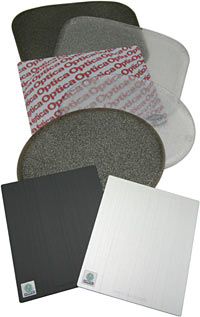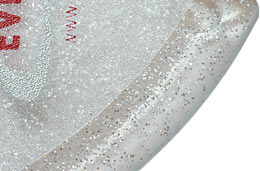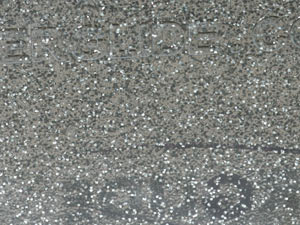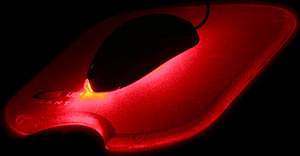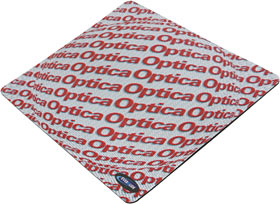
Lian Li aluminium and Everglide optical mouse mats
Review date: 7 September 2002.Last modified 03-Dec-2011.
One day, people are going to run out of new ideas for mousemats.
I may not live to see it, but I'm sure the day will come.
Some years ago, computer enthusiasts suddenly discovered that there were better things to put under your mouse than the ubiquitous wetsuit-fabric oblongs, or the slightly better rubber-backed plastic promotional mats featuring, on my favourite one, ads for the local grease trap cleaning outfit.
Hard plastic mats resembling kitchen chopping boards are big favourites with a lot of people these days, including me. They're tough as old boots, they don't bend or curl, and they've got a texture on the top that helps keep the mouse clean (not that that's a big issue these days, with all-surface optical-sensor mouses in common use), and also makes the mat very low friction, so your mouse is easier to move.
If you don't care for the super-slick zero-friction feel then there are other options, but a lot of people who don't like hard mats at first find they're good, once you get used to them.
Here are some of the latest offerings in the burgeoning and very interesting (in case you were wondering) premium mouse mat market sector.
The two rectangles at the front are from expensive-aluminium-case company Lian Li; everything else is from Everglide.
Everglide are the most widely recognised name in mousemats-you-could-cut-carrots-on. I rather like their new mats.
But first, the Lian Lis.
Metal mats
You're looking at Lian Li's M-2 (silver) and M-2B (black) mousemats. They're round-cornered 190 by 165mm (7.5 by 6.5 inch) rectangles of hard-anodised aluminium. That's the same stuff Lian Li make their cases from, but here it's got a rubber backing that makes the whole mat a bit more than three millimetres (about an eighth of an inch) thick. The aluminium itself is a hair more than a millimetre thick, which means it's not too easy to bend; I don't think anybody's likely to put a crease in one of these things by mistake.
There's a Lian Li case badge in the bottom left corner of each mat (you could pry it off if it annoyed you), and the Lian Li URL's engraved on the bottom edge. The M-2 costs $AU18.70 delivered from Aus PC Market here in Australia; the M-2B costs $AU19.80.
Aluminium is not a hard metal, but with a good thick layer of anodised oxide on it (the only difference between "hard anodising" and the regular kind is the thickness of the oxide layer) it's surprisingly hard-wearing. I wouldn't be too concerned about these mats wearing out.
They also work just fine with optical mouses; the brushed-metal surface texture has enough detail that the little goblin-powered camera in the bottom of the mouse can see where it's being moved and track with no trouble.
The M-2's silver finish doesn't show fingerprints particularly; prints are more visible on the M-2B.
These aren't very big mousemats, but they're actually likely to be a pretty good size for most people, provided you don't have your mouse sensitivity set low enough that you have to move your whole lower arm to get the pointer from one side of the screen to the other.
These mats also have a decent low friction feel. They're not quite as slick as a textured plastic mat, but they're not anywhere near as draggy as an old-style cloth mat either. I don't mind the feel of them at all.
Since these mats don't have any real texture depth, though, dust and scunge can't fall into valleys and stay off the mouse feet. Textured mats can get quite filthy and still feel fine; the Lian Li, in contrast, will gum up slowly, pretty much like a plain desk surface with no mat on it.
Lots of people don't seem to mind mousing surfaces that're so dirty they'd probably be a good place to grow potatoes, but if you can't tolerate a mouse that sticks and slips and tracks unevenly, I bet you'll find yourself washing a Lian Li mat more often than you'd be washing a textured one.
That said, these mats are very washable. A quick scrub in the sink will make them good as new.
And now, on with the plastic.
Sparkly!
Everglide have a problem.
The problem is that their mousemats don't wear out. Well, not fast enough, anyway. Diligent use of a hard plastic mousemat will, over a year or three, polish it down, and it's possible to gouge it or lose it or absent-mindedly put it in the oven for an hour on high. But, generally speaking, the things just last and last.
If you want to sell more mousemats, that's bad. It leaves you trying to find new and exciting products that'll induce people to upgrade.
There's only so much a manufacturer can do with the hard plastic mousemat concept. They can make them in different shapes and sizes, but Everglide standardised on three basic shapes some time ago, and probably aren't itching to start bringing out limited-run love-heart, map-of-Texas and pentagram versions.
They've tried making mats with weird stuff printed on them, possibly in hopes that gamers will keep a bag full of mats with appropriate printing on them for the game currently being played, but I can't honestly say game-promoting mousemats strike me as being something that you ought to have to pay for.
Everglide's latest innovation, though, is in even my curmudgeonly opinion, pretty cool. It's associated with a bit of a problem, though.
Everglide mats were originally made of polyethylene. That's a very tough plastic, which wears out very slowly.
In March 2001, though, they switched to polystyrene. There were a few other changes made in this "reengineering", which are mentioned in the press release, but the change of materials was a biggie.
The new plastic made the mats noticeably harder. Unfortunately, it didn't make them longer lasting. There were sufficient complaints about the white, black and blue polystyrene mats wearing out faster than the polyethylene ones that my sponsor, Aus PC Market, stopped stocking the things. I've independently verified this now, by the highly scientific method of using one of the mats for a few months; in only two months of regular use, from the time I first wrote this review to this update I'm writing now, a polystyrene Everglide has gone from its initial textured-all-over finish to being quite noticeably worn. The worn out part of the mat has considerably more drag. I wouldn't say the mat is worn out yet, but it won't be much longer before it is. Polystyrene is not a good material for textured mousemats.
The original polyethylene, in contrast, isn't very rigid, but it's extremely tough. You can wear out a polyethylene mat eventually, but it takes a long time.
Besides its unfortunate effect on durability, polystyrene made it possible for Everglide to make the mats clear.
The natural state of polystyrene is crystal-clear; you have to add pigment to it to make it any other colour. Polystyrene is the stuff used for ordinary CD jewel cases; that's how clear it is. Jewel cases are fragile because their plastic is thin; Everglide mats are thick enough that attempts to break them are more likely to break you.
So, when Everglide started making mats out of polystyrene, they could make clear mats.
Except they couldn't, because a clear mat won't work with an optical mouse. Modern optical mouses only work on surfaces that aren't transparent, translucent or reflective (old-fashioned opticals were even pickier; they needed special patterned pads).
Everglide's original milky-white pads, therefore, are no good for opticals. Varnished desks can be dodgy, too.
It turns out, however, that you can make a clear mouse mat that'll work with an optical mouse. You just have to add stuff to the plastic that the mouse can see.
It would appear that the best stuff to add is glitter.
Hence, these. They've got the normal Everglide Attack Pad (oval) and Giganta (rectangular) form factors, but the "Optical" versions were made of clear polystyrene with glitter in it, and the "Optical Smoke" versions are grey-tinted, with a larger dose of glitter.
The polystyrene mats wore out fast, so Everglide changed the formulation again. Back to polyethylene, I think. I've played with the new-new models of Optical pad now, and they're milkier in appearance than the ones photographed above; you can't make crystal clear polyethylene. I haven't tested the new-new pads long enough to be sure, but I think it's a pretty safe bet to say that they'll last as long as the original Everglides.
If you're wondering whether you're looking at a polystyrene or a polyethylene mouse pad, hold the thing by one edge and tap it sharply with your knuckle. Polystyrene will ring like a bell; polyethylene will just go "tap", as if you were knocking on a door. The difference is dramatic.
When I first wrote this review, the Optical Attack Pads were $US15.95 plus shipping from Everglide, and the Optical Gigantas were $US17.95 plus shipping. As I write this update, though (on the 15th of February, 2003), there's no sign of them in the official Everglide store at all. There's a page for them, but there's nothing on it. Presumably they'll be back.
The regular Attack Pads and Gigantas, which only seem to be available in black these days, are now $US12.95 and $US14.95 respectively. And, as I write this update, Everglide are offering a free set of Mouse Skatez tape with every order. Which is nice, but doesn't help you find an Optical pad.
Australian shoppers can buy Everglide products from Everglide Australia, who currently have Optical Attack Pads for $AU35 plus shipping, and Optical Gigantas for $AU45 plus shipping. The clear (or, now, "milky"...) Optical Giganta is on special for $AU39, as I write this.
Here's the edge of a polystyrene Attack Pad Optical; the glitter's more visible through the un-textured bevel. Like all of the hard plastic Everglides, the surface of these mats is about 8mm above the desk, but the smooth edge stops the relatively tall mat from chafing your arm.
The twinkly mats are really quite pretty. This is a detail shot of a clear mat...
...and this is a less magnified detail shot of a Smoke mat. The milkier polyethylene versions spoil the effect only a little. They still look neat.
(This latter picture, by the way, struck me as being weird enough that you might want it as your desktop wallpaper. If you do, you can get a 1024 by 768 version here, a 1280 by 960 version here, and a 1600 by 1200 version here. Don't mention it.)
Everglide call the glitter "Reactive Agent", but I haven't noticed it reacting to anything. It just sits there and reflects. And it does, indubitably, make these clear mats work fine with optical mouses.
That's not all it does, though. Everglide also assert that these mats can give longer battery life from cordless optical mouses, because those mouses adjust their illuminating LED brightness to give their little camera a good exposure level, and they need less brightness if you use a more reflective mousemat, and lower brightness means less power consumption.
The main way cordless optical mouses save power isn't by changing the LED brightness. Some of them don't do that at all. What they all do is run the LED as little as possible.
When you stop moving a cordless optical, the flash rate of its LED will drop from an apparently constant super-high rate (which matches the 1500-or-more-pictures-per-second of the camera chip) to a much slower pulse, which is still adequate for the mouse to tell when you've moved it again and snap back into full power operation. The longer you leave the mouse alone, the slower the pulse gets, and the longer will be the lag before the mouse notices you've moved it. But, in practice, even the slowest pulse rates seem to be adequate.
Some cordless mouses turn the LED off entirely as their final power-saving step, which renders them unable to detect movement at all, so you have to press a button to wake them up again.
Logitech's Cordless MouseMan Optical (reviewed here) has the LED-brightness-control feature. I hooked it up to the multimeter and wiggled it around on some different mats to see how much difference there was.
On my old blue Giganta, it drew 40mA from two AA cells. That dropped to 37mA on the Lian Li M-2B, to 35mA on a polystyrene "Smoke" Everglide mat, to 32mA on the Lian Li M-2, and to 30mA on a polystyrene clear Everglide.
Next, I tried the cordless mouse from the A4 Tech KBS-835RP mouse and keyboard set (reviewed here). This mouse is rechargeable and so its battery life isn't really that important, but it's also a perfect example of a simpler cordless mouse that doesn't bother doing LED brightness adjustment. Its current consumption stayed exactly the same no matter what surface I wiggled it on.
So, assuming that you don't leave your cordless mouse sitting around doing nothing for so long that the shelf life of the batteries becomes an issue, and assuming that your cordless mouse is actually able to do LED brightness adjustment, there genuinely is a reason to use a more reflective mousemat. It's not just marketing blather.
Most people, of course, don't use cordless mouses. Certainly, most gamers don't, at least not if they've managed to notice that cordless mouses tend to have much lower sample rates than corded ones (although some don't). The sample rate is how often the pointer position is updated; the higher it is, the smoother your pointer movement will be, at least until the sample rate is well above the frame rate of whatever game you're playing. For a long time, the only cordless mouses with a half-decent sample rate were the cheap ones; you didn't get smooth aiming from Microsoft or Logitech models. Now things have improved, with Logitech's MX700 and the weird Microsoft Bluetooth mouse I mention here.
Most gamers still use corded mouses, though, and are likely to continue to do so for as long as cordless mouses weigh more than the regular kind. So, as far as Everglide's twitch-game-enthusiast demographic goes, this whole power saving thing is pretty much pointless. People who don't need (or notice) super-silky mouse response, though, do fine with cordless mouses, and it doesn't hurt to have to buy batteries less often.
For most people, the twinkly Everglides are all about looks, and for one US buck extra, I reckon they're good value compared with the other Everglides. I mean, it's not every mousemat that looks like this in the dark...
...is it?
(Note - that's a Microsoft Intellimouse Explorer 3.0, as reviewed here, on the mat. Fancy mouse not included. Mat will not look like this if room is not dark and mouse on mat does not glow. Contents may have settled during shipping.)
Now, the polystyrene Everglides were just not good products. They didn't last. When I first wrote this review I was complimentary about them, because I didn't think Everglide would be dumb enough to make "new and improved" mousemats that wore out faster than the old ones. Well, it turns out that Everglide were dumb enough to do that, and paid the price, and changed the formulation again.
With any luck, all of the polystyrene mats are out of the retail pipeline by now, but if you buy your mats mail order then you won't be able to do the knuckle-tap test until it's too late. So sort it out with the retailer first. Everglide Australia assure me that they're selling the polyethylene models.
And now, Everglide's floppy option.
The Optica
The Optica is one of Everglide's Gaming Mats. They look not unlike ordinary rubber-backed flexible plastic mats, such as you can get for free from various businesses that are a bit classier than the businesses that still hand out nasty wetsuit-fabric mats. The Gaming Mats have a better surface on them, though; I wouldn't say the scratch-resistant vinyl surface is streets ahead of a plain matte-finish plastic-topped pad, but it is a bit better.
They're about 203 by 267mm in size (eight by 10.5 inches), and less than two millimetres tall (about 1/16th of an inch), which is considerably thinner than a lot of these sorts of mats.
The Gaming Mat texture is finer than that on the hard Everglide mats, so it feels smoother when you use it. It's got about the same friction; maybe a little more, but it's nothing noticeable. What is noticeable is that the flexible, rubber-backed Gaming Mat is considerably quieter than the Giganta; the hard mats' coarser texture and stiff plastic make more racket when you drag a mouse across them.
You'd have to be rather extraordinarily sensitive to noise for the sound of a mouse being moved over a hard plastic mat to irritate you, if you ask me. But the difference is still quite noticeable.
The only difference between the Optica and the other Gaming Mats is what's printed on it. The Optica's white, grey and red design is lighter than the printing on the other Gaming Mats, so, once again, it ought to save a bit of cordless mouse battery life.
That's it for this mat's remarkable features, but the Optica only costs $US9.95 plus shipping from Everglide, and for that money it's a perfectly good product.
Well, it is if you can buy one. The Optica's gone AWOL from Everglide's shopping site as well, as I write this. Everglide Australia have it, though, for $AU24 plus shipping.
Overall
I wasn't expecting anything great from the Lian Li mousemats, as they really looked like something that'd been created from offcuts. Nicely machined, very well finished offcuts, sure, but it's not as if someone spent three years doing wind tunnel tests on prototypes.
They're fine, though. They're quite strong, quite slick, and big enough, and they look rather natty. They're not cheap, but they're not especially expensive by fancy mousemat standards, either.
So while I can't say I held the M-2 and M-2B up to the sky and yelled "Gaze, gods, upon the wonders wrought by man!", I also can't say I disliked them. They're good little metal mousemats. Nobody else seems to make a metal mousemat. If you want a novel mousemat that works fine and doesn't cost the earth, an M-2 or M-2B may be just what you're after.
Note, however, that one correspondent's told me that he's got one of these mats, and found that it stops two cordless mouses (the mouse from a Logitech Cordless Freedom kit, and an older Logitech Cordless as well) from working. This is presumably because the mouses' transmitters can't get a signal to the receiver with a metal plate near their antenna. Your mileage may vary.
The Everglide Optica's decent, too. I wouldn't mind using one at all. Floppy mats are easier to pack into your bag-o-bits if you're toting your computer around, and this one feels nice and seems likely to last well, too.
The original glittery Everglides looked great, but wore out too fast, just like the rest of the polystyrene mats. I reviewed the original Giganta when it first came out, and after a year of hard use, it was noticeably worn, but still useable. The polystyrene Giganta wore out four or five times faster than the polyethylene one did, which wasn't acceptable. An occasional squirt of silicone oil will keep a worn plastic mat decently zippy, but the things just shouldn't wear out this fast.
Now, though, the things are made from tough plastic again, and should once again last as long as any reasonable person can expect a mousemat to last.
The twinkly Everglides have something to offer cordless optical mouse users, but their new features are basically just for pretty. There's nothing wrong with pretty, though, and there also shouldn't be anything wrong with their durability, any more.
When I first reviewed the Optical Everglides, I recommended them. Then I didn't. Now I do again.
Who knew mousemats could be this complicated?
Everglide mats kindly provided by
Everglide
and
Everglide Australia
Buy a mat!
Readers from Australia or New Zealand can purchase fancy mousemats from
Aus PC Market.
(if you're NOT from Australia or New Zealand, Aus
PC Market won't deliver to you. If you're in the USA, try a price search
at
DealTime!)
